by Jason Bodner
September 10, 2024
Louis Navellier sometimes humorously says we should just close the market in August, since much of Wall Street is on vacation and the trading desks are staffed by the “B” team. That turns August into a generally miserable month, packed with trading shenanigans and volatility.
Fair enough, but I hereby vote that we add September to that list. I’ll go one step further: If I had to choose between the two months, I would leave August alone and close September. Why? Historically speaking, September is unanimously the worst month of the year, measured by market performance.
Here we see monthly performance on average of the four major U.S. stock indexes, since 1990:
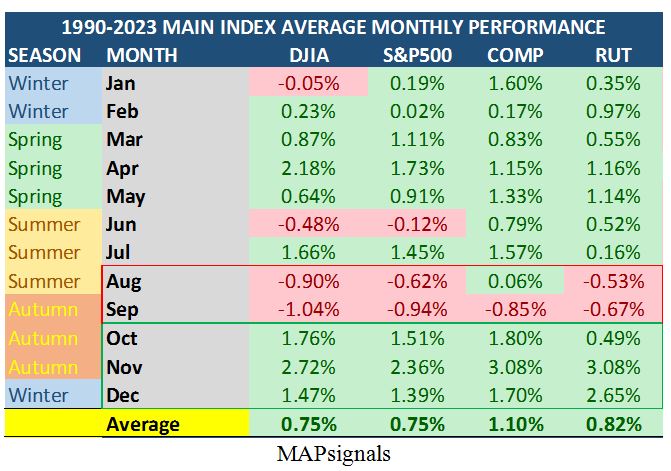
Graphs are for illustrative and discussion purposes only. Please read important disclosures at the end of this commentary.
September is mostly pretty ugly. Visualizing the above table as a bar graph makes it even clearer:
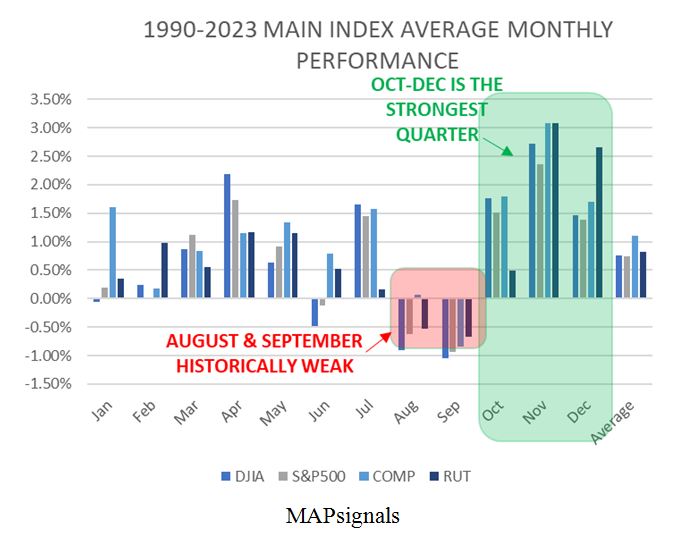
Graphs are for illustrative and discussion purposes only. Please read important disclosures at the end of this commentary.
In the four trading days last week, the four major indexes saw at least three down days, with the Russell 2000 trading down all four days. The Dow had a tiny gain on Wednesday and NASDAQ rose on Thursday.

Graphs are for illustrative and discussion purposes only. Please read important disclosures at the end of this commentary.
On Friday, we fared little better, with the market having trouble digesting the latest payroll report, which suggests we may be in worse shape than investors thought, after all those continuing downward revisions.
So… Welcome to September!
Even though September is the worst month of the year, historically, it’s still mostly a coin flip whether it ends up or down. Here we see all 34 Septembers and how things shook out… it’s nearly a push, 17-17:
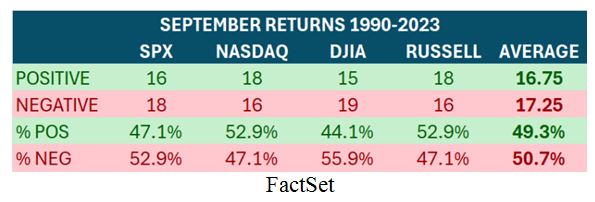
Graphs are for illustrative and discussion purposes only. Please read important disclosures at the end of this commentary.
The net negative results can be explained by the fact that the miserable Septembers more than erased the smaller September gains. Below, we see that a few bad apples really did spoil the bunch:
The worst culprits are highlighted below, 2000 to 2002, 2008 and 2022.

![]()
Graphs are for illustrative and discussion purposes only. Please read important disclosures at the end of this commentary.
Even if we took out the bad string from 2000 to 2002, the recent Septembers would still just be “flat” …
But don’t panic. We are still in the early innings for this September – only four of 20 trading days are in the books – so we still have to wait and see. But there are a few things to keep in mind:
- September seasonality says we should expect a bumpy month, and we are right on cue.
- We are on the precipice of some potentially significant Fed policy changes on September 18th.
- We are in a Presidential election year, which is unsettling – until election day, November 5th.
- Historically, October through December are great months for stocks.
If we do the same exercise as above for October, November and December, we see something very cool…
- October markets are positive 63% of the time, up an average 1.4%
- Novembers are positive 73.5% of the time, up an average 2.8%, and
- Decembers are positive 72.1% of the time, up an average 1.8%.
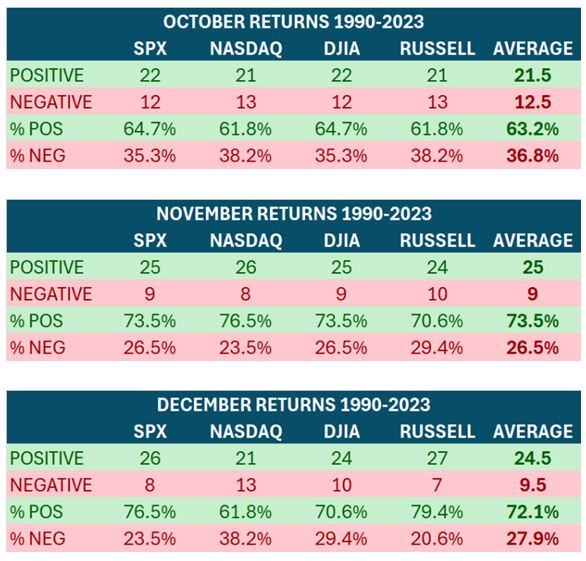
![]()
Graphs are for illustrative and discussion purposes only. Please read important disclosures at the end of this commentary.
And let’s look again at those average returns for those 4th quarter months:

![]()
Graphs are for illustrative and discussion purposes only. Please read important disclosures at the end of this commentary.
So, let’s recap here:
- We have a 50/50 shot of a cruddy September… Here we are, but there’s three more trading weeks.
- Fourth quarters are the best time of the year since 1990
- Fourth quarters are great roughly 70% of the time.
I definitely like our fourth quarter odds. And with rate cuts imminent, I think we have the odds in our favor for a nice lift by the end of year. Meanwhile, here on the ground, the Big Money Index (BMI) is chopping around since July. Money flows have been moving in and out of stocks in a rotational market:
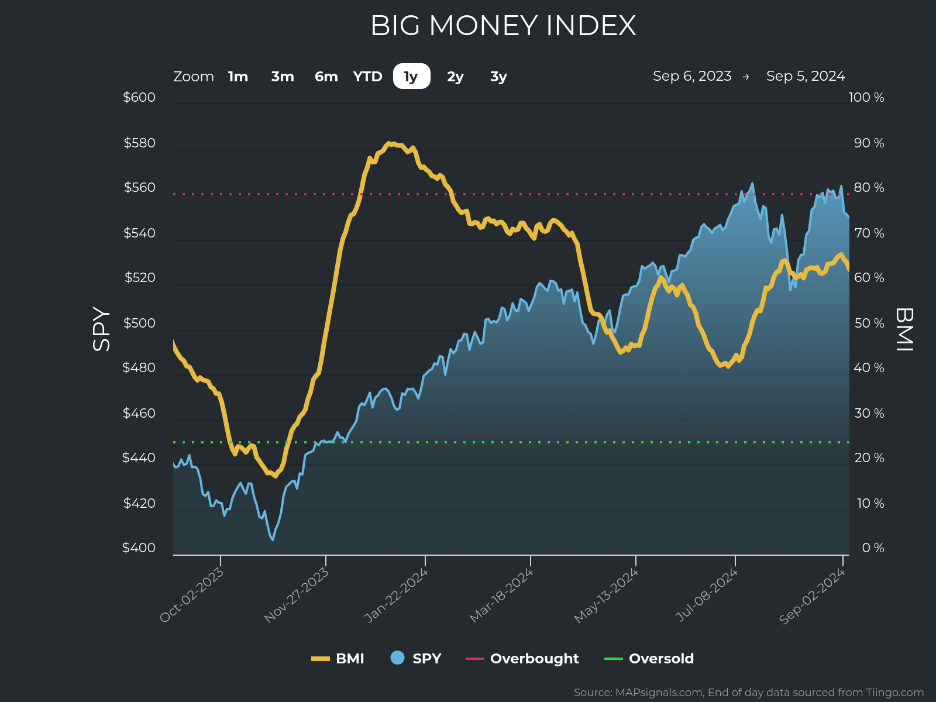
![]()
Graphs are for illustrative and discussion purposes only. Please read important disclosures at the end of this commentary.
The BMI is driven by the unusual buying and selling of stocks:
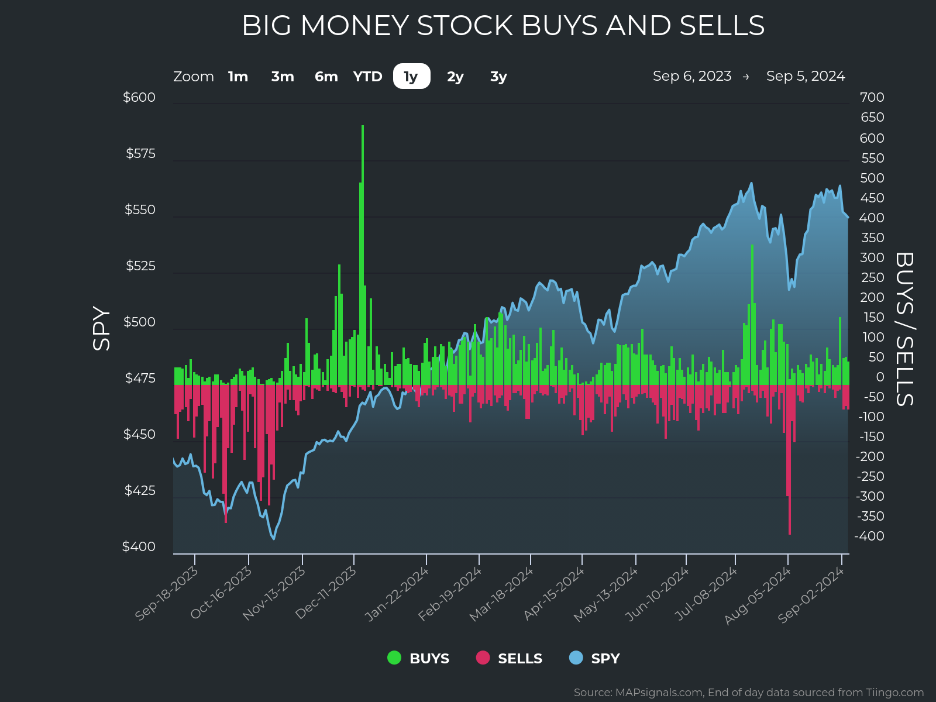
![]()
Graphs are for illustrative and discussion purposes only. Please read important disclosures at the end of this commentary.
As we can see, the latest leg down in the market has not been on immense selling. With September, a seasonally bumpy time of year, I think traders come back from summer vacations and push stocks down to buy them up in the fourth quarter gain. The data support this hypothesis.
And looking at September thus far, we see that buying is still slightly more in control than selling. And a bulk of that buying has been in companies between $5 and $50 billion in size:
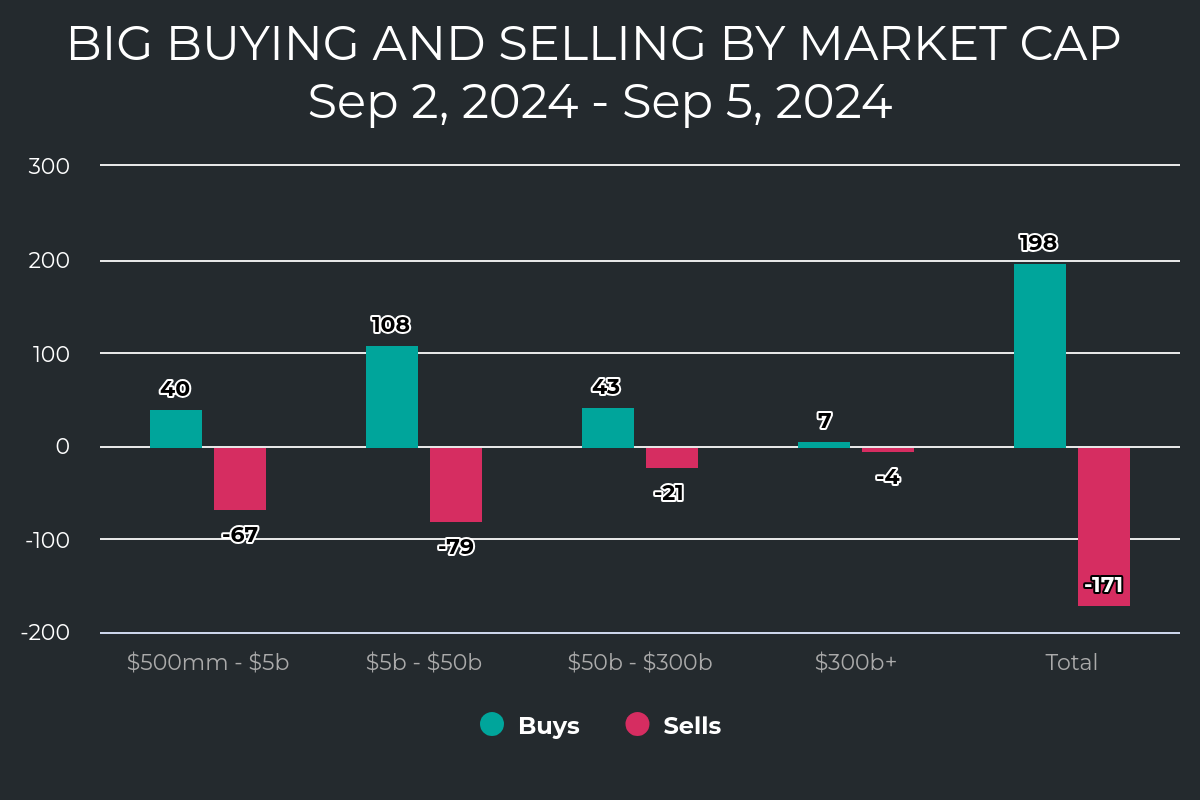
![]()
Graphs are for illustrative and discussion purposes only. Please read important disclosures at the end of this commentary.
All this is to say that we can expect continued volatility now and for a little while more. When the election is out of the way and the trajectory of our government comes into clearer focus, we can expect markets to resume lower volatility, and then it’s likely to be long-term uptrend. And I say this regardless of the election winner. Either side has different impacts in different parts of the market, but Wall Street likes certainty, of and by itself. When we know what we’re going to get, we can expect smoother sailing.
One other key point to consider. Our research shows that slow Fed rate cuts are bullish for stocks. The next round of rate cuts are expected to start next week, on September 18th. The talk is now whether or not we will get 50 basis points (0.50%) in cuts, or 25 bps. My thoughts are that the Fed doesn’t want to appear like they are behind the curve – which they are. With continued downward revisions in the payroll reports, the economy looks worse than before. But we are not in an economic free fall and they don’t want recession. For those reasons, I expect a 25 bp cut. And that’s actually good news… because when easing has been slow, the S&P 500 is up 24% on average one year after the first rate cut. When the cuts are bigger and quicker, the gains are 6.1%, well below the S&P 500’s historical 10% average annual gain:
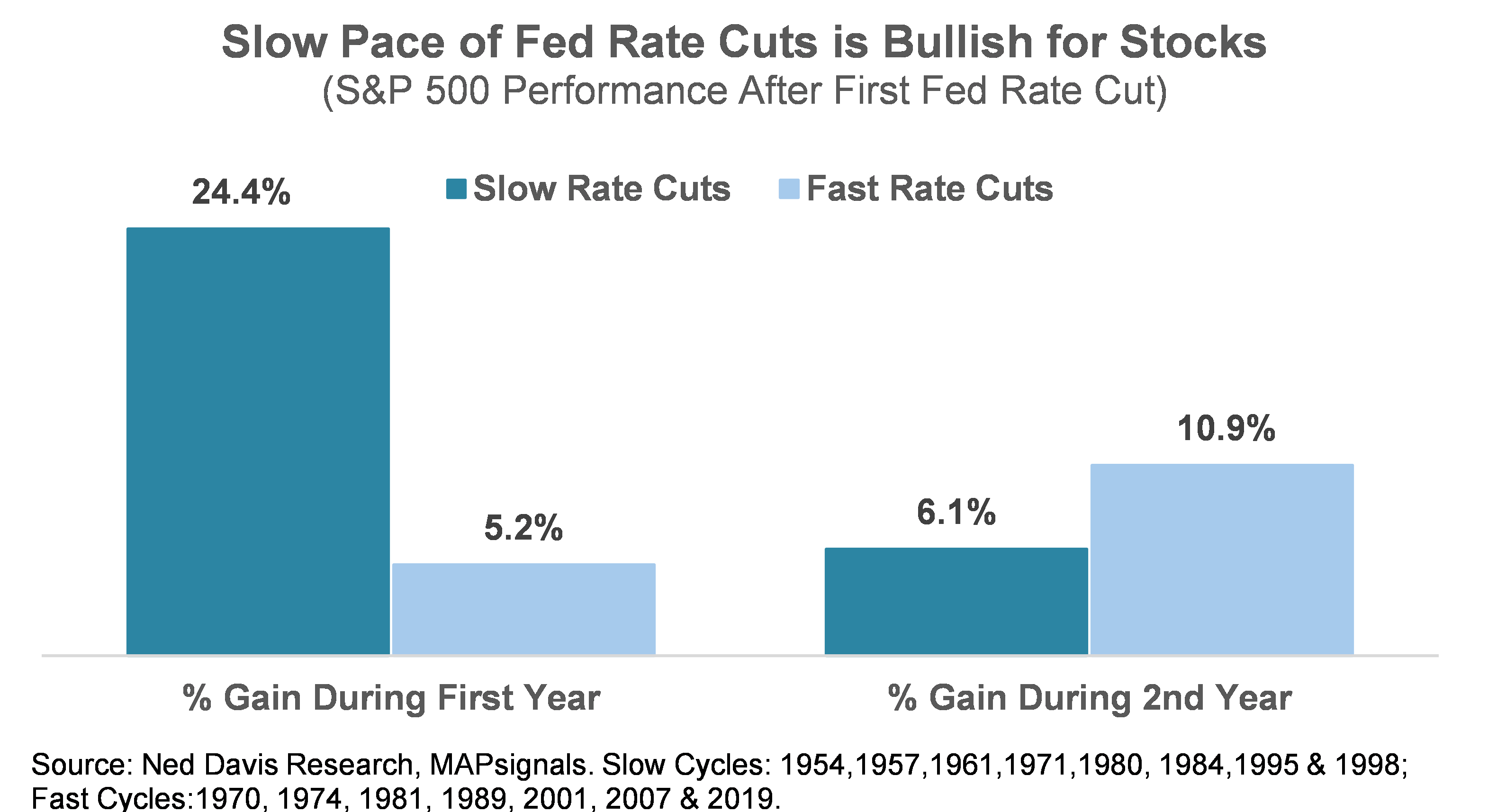
Graphs are for illustrative and discussion purposes only. Please read important disclosures at the end of this commentary.
The reason is that quicker rate cuts usually mean a crisis is happening, which isn’t true now. Our research also points out that you should buy pre-election dips because after the election markets usually rip:
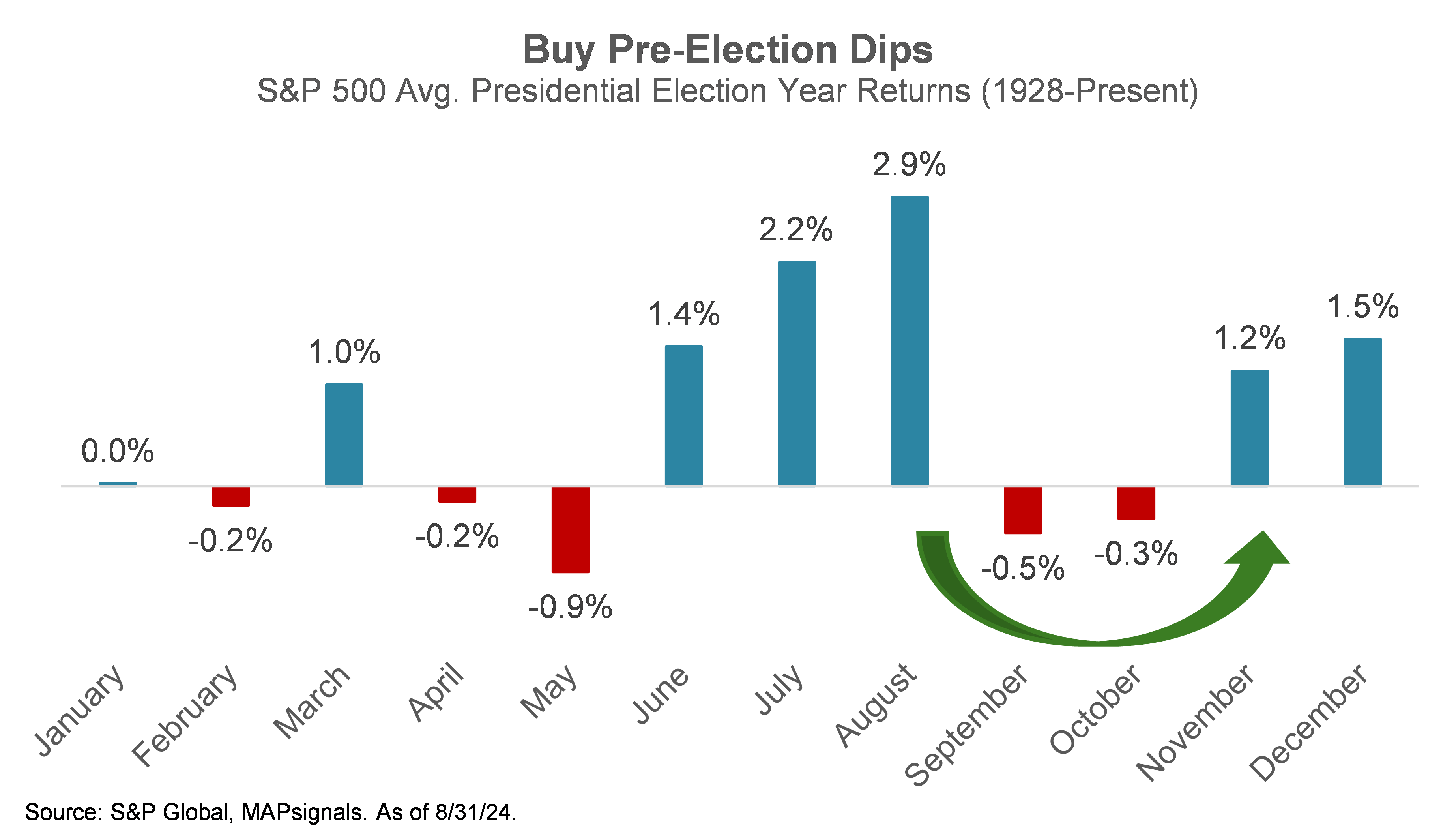
Graphs are for illustrative and discussion purposes only. Please read important disclosures at the end of this commentary.
“September tries its best to have us forget summer.” — Bernard Williams.
All content above represents the opinion of Jason Bodner of Navellier & Associates, Inc.
Also In This Issue
A Look Ahead by Louis Navellier
Another Downbeat Jobs Report – Plus More Downward Revisions
Income Mail by Bryan Perry
A “Compression Cycle” Hits the Market on Weaker Labor Data
Growth Mail by Gary Alexander
“SEPTOBER” in Market History – Especially in Election Years
Global Mail by Ivan Martchev
This is Just Normal Seasonal Jitters
Sector Spotlight by Jason Bodner
If Given a Choice, Would You Cancel August – or September?
View Full Archive
Read Past Issues Here

Jason Bodner
MARKETMAIL EDITOR FOR SECTOR SPOTLIGHT
Jason Bodner writes Sector Spotlight in the weekly Marketmail publication and has authored several white papers for the company. He is also Co-Founder of Macro Analytics for Professionals which produces proprietary equity accumulation and distribution research for its clients. Previously, Mr. Bodner served as Director of European Equity Derivatives for Cantor Fitzgerald Europe in London, then moved to the role of Head of Equity Derivatives North America for the same company in New York. He also served as S.V.P. Equity Derivatives for Jefferies, LLC. He received a B.S. in business administration in 1996, with honors, from Skidmore College as a member of the Periclean Honors Society. All content of “Sector Spotlight” represents the opinion of Jason Bodner
Important Disclosures:
Jason Bodner is a co-founder and co-owner of Mapsignals. Mr. Bodner is an independent contractor who is occasionally hired by Navellier & Associates to write an article and or provide opinions for possible use in articles that appear in Navellier & Associates weekly Market Mail. Mr. Bodner is not employed or affiliated with Louis Navellier, Navellier & Associates, Inc., or any other Navellier owned entity. The opinions and statements made here are those of Mr. Bodner and not necessarily those of any other persons or entities. This is not an endorsement, or solicitation or testimonial or investment advice regarding the BMI Index or any statements or recommendations or analysis in the article or the BMI Index or Mapsignals or its products or strategies.
Although information in these reports has been obtained from and is based upon sources that Navellier believes to be reliable, Navellier does not guarantee its accuracy and it may be incomplete or condensed. All opinions and estimates constitute Navellier’s judgment as of the date the report was created and are subject to change without notice. These reports are for informational purposes only and are not a solicitation for the purchase or sale of a security. Any decision to purchase securities mentioned in these reports must take into account existing public information on such securities or any registered prospectus.To the extent permitted by law, neither Navellier & Associates, Inc., nor any of its affiliates, agents, or service providers assumes any liability or responsibility nor owes any duty of care for any consequences of any person acting or refraining to act in reliance on the information contained in this communication or for any decision based on it.
Past performance is no indication of future results. Investment in securities involves significant risk and has the potential for partial or complete loss of funds invested. It should not be assumed that any securities recommendations made by Navellier. in the future will be profitable or equal the performance of securities made in this report. Dividend payments are not guaranteed. The amount of a dividend payment, if any, can vary over time and issuers may reduce dividends paid on securities in the event of a recession or adverse event affecting a specific industry or issuer.
None of the stock information, data, and company information presented herein constitutes a recommendation by Navellier or a solicitation to buy or sell any securities. Any specific securities identified and described do not represent all of the securities purchased, sold, or recommended for advisory clients. The holdings identified do not represent all of the securities purchased, sold, or recommended for advisory clients and the reader should not assume that investments in the securities identified and discussed were or will be profitable.
Information presented is general information that does not take into account your individual circumstances, financial situation, or needs, nor does it present a personalized recommendation to you. Individual stocks presented may not be suitable for every investor. Investment in securities involves significant risk and has the potential for partial or complete loss of funds invested. Investment in fixed income securities has the potential for the investment return and principal value of an investment to fluctuate so that an investor’s holdings, when redeemed, may be worth less than their original cost.
One cannot invest directly in an index. Index is unmanaged and index performance does not reflect deduction of fees, expenses, or taxes. Presentation of Index data does not reflect a belief by Navellier that any stock index constitutes an investment alternative to any Navellier equity strategy or is necessarily comparable to such strategies. Among the most important differences between the Indices and Navellier strategies are that the Navellier equity strategies may (1) incur material management fees, (2) concentrate its investments in relatively few stocks, industries, or sectors, (3) have significantly greater trading activity and related costs, and (4) be significantly more or less volatile than the Indices.
ETF Risk: We may invest in exchange traded funds (“ETFs”) and some of our investment strategies are generally fully invested in ETFs. Like traditional mutual funds, ETFs charge asset-based fees, but they generally do not charge initial sales charges or redemption fees and investors typically pay only customary brokerage fees to buy and sell ETF shares. The fees and costs charged by ETFs held in client accounts will not be deducted from the compensation the client pays Navellier. ETF prices can fluctuate up or down, and a client account could lose money investing in an ETF if the prices of the securities owned by the ETF go down. ETFs are subject to additional risks:
- ETF shares may trade above or below their net asset value;
- An active trading market for an ETF’s shares may not develop or be maintained;
- The value of an ETF may be more volatile than the underlying portfolio of securities the ETF is designed to track;
- The cost of owning shares of the ETF may exceed those a client would incur by directly investing in the underlying securities and;
- Trading of an ETF’s shares may be halted if the listing exchange’s officials deem it appropriate, the shares are delisted from the exchange, or the activation of market-wide “circuit breakers” (which are tied to large decreases in stock prices) halts stock trading generally.
Grader Disclosures: Investment in equity strategies involves substantial risk and has the potential for partial or complete loss of funds invested. The sample portfolio and any accompanying charts are for informational purposes only and are not to be construed as a solicitation to buy or sell any financial instrument and should not be relied upon as the sole factor in an investment making decision. As a matter of normal and important disclosures to you, as a potential investor, please consider the following: The performance presented is not based on any actual securities trading, portfolio, or accounts, and the reported performance of the A, B, C, D, and F portfolios (collectively the “model portfolios”) should be considered mere “paper” or pro forma performance results based on Navellier’s research.
Investors evaluating any of Navellier & Associates, Inc.’s, (or its affiliates’) Investment Products must not use any information presented here, including the performance figures of the model portfolios, in their evaluation of any Navellier Investment Products. Navellier Investment Products include the firm’s mutual funds and managed accounts. The model portfolios, charts, and other information presented do not represent actual funded trades and are not actual funded portfolios. There are material differences between Navellier Investment Products’ portfolios and the model portfolios, research, and performance figures presented here. The model portfolios and the research results (1) may contain stocks or ETFs that are illiquid and difficult to trade; (2) may contain stock or ETF holdings materially different from actual funded Navellier Investment Product portfolios; (3) include the reinvestment of all dividends and other earnings, estimated trading costs, commissions, or management fees; and, (4) may not reflect prices obtained in an actual funded Navellier Investment Product portfolio. For these and other reasons, the reported performances of model portfolios do not reflect the performance results of Navellier’s actually funded and traded Investment Products. In most cases, Navellier’s Investment Products have materially lower performance results than the performances of the model portfolios presented.
This report contains statements that are, or may be considered to be, forward-looking statements. All statements that are not historical facts, including statements about our beliefs or expectations, are “forward-looking statements” within the meaning of The U.S. Private Securities Litigation Reform Act of 1995. These statements may be identified by such forward-looking terminology as “expect,” “estimate,” “plan,” “intend,” “believe,” “anticipate,” “may,” “will,” “should,” “could,” “continue,” “project,” or similar statements or variations of such terms. Our forward-looking statements are based on a series of expectations, assumptions, and projections, are not guarantees of future results or performance, and involve substantial risks and uncertainty as described in Form ADV Part 2A of our filing with the Securities and Exchange Commission (SEC), which is available at www.adviserinfo.sec.gov or by requesting a copy by emailing info@navellier.com. All of our forward-looking statements are as of the date of this report only. We can give no assurance that such expectations or forward-looking statements will prove to be correct. Actual results may differ materially. You are urged to carefully consider all such factors.
FEDERAL TAX ADVICE DISCLAIMER: As required by U.S. Treasury Regulations, you are informed that, to the extent this presentation includes any federal tax advice, the presentation is not written by Navellier to be used, and cannot be used, for the purpose of avoiding federal tax penalties. Navellier does not advise on any income tax requirements or issues. Use of any information presented by Navellier is for general information only and does not represent tax advice either express or implied. You are encouraged to seek professional tax advice for income tax questions and assistance.
IMPORTANT NEWSLETTER DISCLOSURE:The hypothetical performance results for investment newsletters that are authored or edited by Louis Navellier, including Louis Navellier’s Growth Investor, Louis Navellier’s Breakthrough Stocks, Louis Navellier’s Accelerated Profits, and Louis Navellier’s Platinum Club, are not based on any actual securities trading, portfolio, or accounts, and the newsletters’ reported hypothetical performances should be considered mere “paper” or proforma hypothetical performance results and are not actual performance of real world trades. Navellier & Associates, Inc. does not have any relation to or affiliation with the owner of these newsletters. There are material differences between Navellier Investment Products’ portfolios and the InvestorPlace Media, LLC newsletter portfolios authored by Louis Navellier. The InvestorPlace Media, LLC newsletters contain hypothetical performance that do not include transaction costs, advisory fees, or other fees a client might incur if actual investments and trades were being made by an investor. As a result, newsletter performance should not be used to evaluate Navellier Investment services which are separate and different from the newsletters. The owner of the newsletters is InvestorPlace Media, LLC and any questions concerning the newsletters, including any newsletter advertising or hypothetical Newsletter performance claims, (which are calculated solely by Investor Place Media and not Navellier) should be referred to InvestorPlace Media, LLC at (800) 718-8289.
Please note that Navellier & Associates and the Navellier Private Client Group are managed completely independent of the newsletters owned and published by InvestorPlace Media, LLC and written and edited by Louis Navellier, and investment performance of the newsletters should in no way be considered indicative of potential future investment performance for any Navellier & Associates separately managed account portfolio. Potential investors should consult with their financial advisor before investing in any Navellier Investment Product.
Navellier claims compliance with Global Investment Performance Standards (GIPS). To receive a complete list and descriptions of Navellier’s composites and/or a presentation that adheres to the GIPS standards, please contact Navellier or click here. It should not be assumed that any securities recommendations made by Navellier & Associates, Inc. in the future will be profitable or equal the performance of securities made in this report.
FactSet Disclosure: Navellier does not independently calculate the statistical information included in the attached report. The calculation and the information are provided by FactSet, a company not related to Navellier. Although information contained in the report has been obtained from FactSet and is based on sources Navellier believes to be reliable, Navellier does not guarantee its accuracy, and it may be incomplete or condensed. The report and the related FactSet sourced information are provided on an “as is” basis. The user assumes the entire risk of any use made of this information. Investors should consider the report as only a single factor in making their investment decision. The report is for informational purposes only and is not intended as an offer or solicitation for the purchase or sale of a security. FactSet sourced information is the exclusive property of FactSet. Without prior written permission of FactSet, this information may not be reproduced, disseminated or used to create any financial products. All indices are unmanaged and performance of the indices include reinvestment of dividends and interest income, unless otherwise noted, are not illustrative of any particular investment and an investment cannot be made in any index. Past performance is no guarantee of future results.
